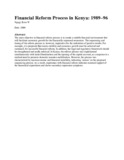| dc.description.abstract | The main objective in financial reform process is to create a suitable financial environment that will facilitate economic growth for the financially repressed economies. The sequencing and timing of the reform process is, however, imperative for the realization of positive results. For example, it is proposed that macro-stability and economic growth must be achieved and sustained, for successful financial reform. In addition, the legal and regulatory framework should be strengthened and easily enforced. In Kenya, the reform process was implemented simultaneously with trade liberalization and the opening of the capital account, as a response to a realized need to promote domestic resource mobilization. However, the process was characterized by macroeconomic and financial instability, indicating `misses’ on the proposed sequencing process. As a result, experience with financial reform indicates minimal support of the theoretical expectation and shows secondary repression symptoms. | en |

